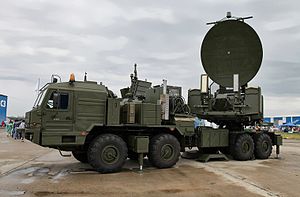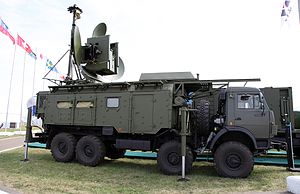Krasukha
| 1L269 Krasukha-2/4 | |
|---|---|
  Krasukha-2 and -4 at Engineering Technologies 2014 | |
| Type | Electronic Counter Measure system |
| Place of origin | Russia |
| Service history | |
| In service | 2014–present |
| Used by | Russian Federation |
| Production history | |
| Designer | KRET corporation |
| Manufacturer | KRET corporation, BAZ (for wheeled platform of Krasukha-4) |
| Produced | 2010–present |
| Variants | 1L269 Krasukha-2 1RL257 Krasukha-4 |
| Specifications | |
Operational range |
|
The Krasukha (Russian: Красуха; English: Belladonna or Deadly Nightshade) is a Russian mobile, ground-based, electronic warfare (EW) system. This system is produced by the KRET corporation on different wheeled platforms.[1] The Krasukha's primary targets are airborne radio-electronics (such as UAVs) and airborne systems guided by radar. The Krasukha has multiple applications in the Russian Armed Forces.[2]
Krasukha-2
[edit]The Krasukha-2 is a S-band system designed to jam Airborne Early Warning and Control (AWACS) aircraft such as the Boeing E-3 Sentry at ranges of up to 250 kilometres (160 mi).[2][3][4] The Krasukha-2 can also jam other airborne radars, such as those for radar-guided missiles. The missiles, once jammed, then receive a false target away from the original to ensure that the missiles no longer pose a threat. The Krasukha-2 guards mobile high-priority targets such as the 9K720 Iskander SRBM.[2]
Krasukha-4
[edit]The Krasukha-4 is a broadband multifunctional jamming station mounted on a BAZ-6910-022 four-axle-chassis. It complements the Krasukha-2 system by operating in the X-band and Ku-band, and counters airborne radar aircraft such as the Joint Surveillance Target Attack Radar System (JSTAR) Northrop Grumman E-8.[4] The Krasukha-4 has enough range to effectively disrupt low Earth orbit (LEO) satellites and can cause permanent damage to targeted radio-electronic devices.[5] Ground based radars are also a viable target for the Krasukha-4.[1]
Operators
[edit]Operational history
[edit]Krasukha jammers were reportedly deployed to support Russian forces in Syria.[10] They have reportedly been blocking small U.S. surveillance drones from receiving GPS satellite signals.[11] During the Turkish intervention in the Syrian civil war, the complex apparently destroyed a Bayraktar drone by causing it to lose control, subsequently crashing.[12] The Israeli Defense Force had problems in 2021 with the Krasukha S-4 GPS denial system.[13]
In July 2018, an OSCE monitoring mission drone recorded a 1L269 Krasukha-2 among other electronic warfare equipment deployed near Chornukhyne, Ukraine.[14]
In 2018, Russia’s Krasukha-4 microwave cannon reportedly grounded an American AH-64 Apache attack helicopter in Syria by damaging its electrical circuits.[15]
In 2020, Krasukha was claimed (without evidence)[16] to have operated around the Russian military base at Gyumri in Armenia to counter the use by Azerbaijan of Turkish-made Bayraktar TB2 armed drones as well as Israel-made Harop loitering munition (suicide drones).[17]
The first export contract was officially signed in August 2021.[18]
Krasukha-4 models are also being employed in the ongoing Russian invasion of Ukraine, as Ukrainian forces captured one of these devices in the field near Kyiv. A photograph posted to social media claims to show part of the system, which has been separated from its truck mount and shows some damage.[19][20] The unit was then sent to the United States for examination.[21]
On 9 August 2023, a source in the Russian defense industry told the state news agency TASS that several Southeast Asian nations and an Eastern European country have ordered the Krasukha and Sapphire EW systems.[22]
See also
[edit]References
[edit]- ^ a b ""Electronic warfare complex "Krasuha-4""". KRET. Archived from the original on 14 July 2015. Retrieved 4 April 2015.
- ^ a b c "1L269 Krasukha-2". Deagel.com. Retrieved 28 March 2015.
- ^ "KRET has fulfilled the state defense order for the delivery of Krasuha-2". Rostek. Archived from the original on 18 March 2015. Retrieved 28 March 2015.
- ^ a b "Fields of silence and broken cycles: Russia's electronic warfare". Global Defence Technology. 18 March 2022. Retrieved 17 October 2022.
- ^ "Krasukha-4". Deagel.com. Retrieved 28 March 2015.
- ^ Secret-difa3 (13 December 2013). "Tout sur la défense au Maghreb: L'Algérie se dote d'un système de brouillage innovant". Tout sur la défense au Maghreb. Retrieved 13 November 2018.
{{cite web}}: CS1 maint: numeric names: authors list (link) - ^ "ЦАМТО / / Эфиопия получила из России комплекс радиоэлектронной борьбы 1РЛ257 "Красуха-4"". ЦАМТО / Центр анализа мировой торговли оружием (in Russian). 30 October 2023. Retrieved 1 November 2023.
- ^ دفاع و امنیت (4 August 2019). "سامانه مرموز جنگال در ایران +فیلم". mashreghnews.ir/service/defence-news. Retrieved 4 August 2019.
- ^ "GNA Turkish UAV airstrike on Electronic Warfare System Krasukha south to Sirte last night Sirte".
- ^ Axe, David (21 October 2017). "The jammer can disrupt an enemy's own signals, potentially preventing ground-based controllers from steering their drones via satellite". Vice News.
Russia deployed Krasukha systems to Syria in an effort to form a sort of electronic shield over Russian and allied forces in the country.
- ^ Varfolomeeva, Anna (1 May 2018). "Signaling strength: Russia's real Syria success is electronic warfare against the US". The Defense Post. Retrieved 12 May 2018.
- ^ "Published a photo of the Turkish Bayraktar TB2, shot down, presumably by the Russian complex "Krasukha"". avia-pro.net. Retrieved 18 May 2021.
- ^ Egozi, Arie (16 April 2023). "Israeli solutions against the most advanced Electronic Warfare systems". Defence Industry Europe.
- ^ OSCE. "Latest from the OSCE Special Monitoring Mission to Ukraine (SMM), based on information received as of 19:30, 10 August 2018". osce.org. Retrieved 14 August 2018.
- ^ "Scientists shrink China's Starlink-killing weapon with new power source". 30 March 2023.
- ^ Lee, Rob (25 November 2020). "There is no evidence that Russian Krasukha-4 EW systems were used in Karabakh". Twitter. Archived from the original on 1 March 2024.
He uses this Asia Times article as his source, which says "If true – and no one has denied it". Really? Does that sound like a serious source?
- ^ Bryen, Stephen (26 October 2020). "Russia knocking Turkish drones from Armenian skies". Asia Times. Retrieved 26 October 2020.
- ^ "Russia inks deals at Army 2021 forum on delivery of latest electronic warfare systems". TASS. 25 August 2021.
- ^ "Ukraine: We managed to identify this bizarre "container", captured today by the UA forces near Kyiv".
- ^ thedrive.com 22 March 2022: Ukraine Just Captured Part Of One Of Russia's Most Capable Electronic Warfare Systems
- ^ Nicholls, Dominic (23 March 2022). "Russian military secrets could be laid bare after Ukraine captures electronic warfare systems". The Telegraph. ISSN 0307-1235. Retrieved 19 July 2022.
- ^ "Southeast Asian nations ordering field-tested anti-drone EW systems from Russian makers". TASS. 9 August 2023.
